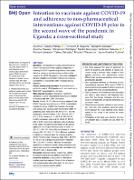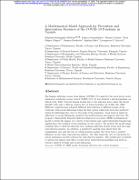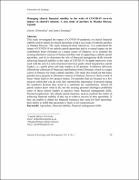| dc.description.abstract | The resurgence in cases and deaths due to
COVID-19 in many countries suggests complacency in
adhering to COVID-19 preventive guidelines. Vaccination,
therefore, remains a key intervention in mitigating the
impact of the COVID-19 pandemic. This study investigated
the level of adherence to COVID-19 preventive measures
and intention to receive the COVID-19 vaccine among
Ugandans.
A nationwide cross-sectional survey of 1053 Ugandan adults was conducted in
March 2021 using telephone interviews.
Main outcome measures Participants reported on
adherence to COVID-19 preventive measures and intention
to be vaccinated with COVID-19 vaccines.
Overall, 10.2% of the respondents adhered to the
COVID-19 preventive guidelines and 57.8% stated definite
intention to receive a SARS-CoV-2 vaccine. Compared
with women, men were less likely to adhere to COVID-19
guidelines (Odds Ratio (OR)=0.64, 95% CI 0.41 to 0.99).
Participants from the northern (4.0%, OR=0.28, 95% CI
0.12 to 0.92), western (5.1%, OR=0.30, 95% CI 0.14
to 0.65) and eastern regions (6.5%, OR=0.47, 95% CI
0.24 to 0.92), respectively, had lower odds of adhering
to the COVID-19 guidelines than those from the central
region (14.7%). A higher monthly income of ≥US$137
(OR=2.31, 95% CI 1.14 to 4.58) and a history of chronic
disease (OR=1.81, 95% CI 1.14 to 2.86) were predictors
of adherence. Concerns about the chances of getting
COVID-19 in the future (Prevalence Ratio (PR)=1.26, 95%
CI 1.06 to 1.48) and fear of severe COVID-19 infection
(PR=1.20, 95% CI 1.04 to 1.38) were the strongest
predictors for a definite intention, while concerns for side
effects were negatively associated with vaccination intent
(PR=0.75, 95% CI 0.68 to 0.83).
Behaviour change programmes need to
be strengthened to promote adherence to COVID-19
preventive guidelines as vaccination is rolled out as
another preventive measure. Dissemination of accurate,
safe and efficacious information about the vaccines is
necessary to enhance vaccine uptake. | en_US |




